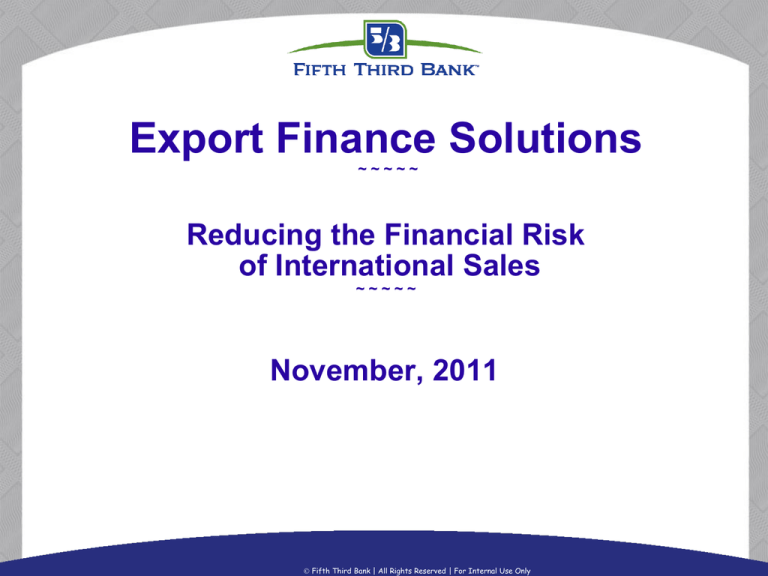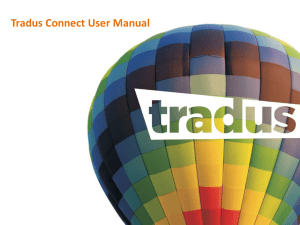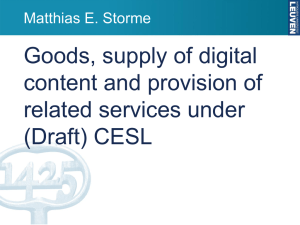
Export Finance Solutions
~~~~~
Reducing the Financial Risk
of International Sales
~~~~~
November, 2011
Fifth Third
Bank
| All
Rights
Reserved
| For
Use
Only
Fifth
Third
Bank
| All Rights
Reserved
| For Internal
Internal Use
Only
What 1st Time Exporters Need to Know
2
Who is your buyer?
How did you “meet”?
How are you communicating? (method / language)
What is your buyer asking you to do?
How does he/she propose to pay?
How do you propose to deliver?
Fifth Third Bank | All Rights Reserved | For Internal Use Only
Comparing Methods of Payment
Cash in Advance
[with counter guaranty]
Letter of Credit
Advised // Confirmed
Documentary Collections
Open Account
3
Fifth Third Bank | All Rights Reserved | For Internal Use Only
Identifying Risks in Cross-Border Sales
What might go wrong?
– Commercial risks
– Political risks
– Transfer/economic risks
– Foreign exchange rate fluctuation risks
4
Fifth Third Bank | All Rights Reserved | For Internal Use Only
Identifying Risks in Cross-Border Sales
Slow payment/default
Financing risk
Bankruptcy
Contract repudiation
Commercial risk
Contract dispute
Contract risk
Abusive bond drawing
Foreign exchange control legislation
Discharge of debt legislation
Government repudiation of debt
Political risk
Payment moratorium
Insurrection/overthrow/domestic turmoil
Non-payment due to war
Non-payment due to natural disasters
Currency inconvertibility
Currency fluctuation/devaluation
5
Transfer/economic risk
FX risk
Fifth Third Bank | All Rights Reserved | For Internal Use Only
Country risk
Letter of Credit: Terminology
The Letter of Credit (L/C) is a well-established financial instrument, used in
international trade for many years, offering security to both buyer and seller.
Commercial L/Cs are governed by Int’l Chamber of Commerce rules (UCP 600, latest revision)
Standby L/Cs are different, and will be discussed later.
“Import L/C”: The buyer is the importer.
The Issuing Bank issues the LC on behalf of the buyer (extending credit to buyer) and
promises to pay on the presentation of documents/drafts, if they comply with L/C terms.
“Export L/C”: The seller is exporting and is named the “Beneficiary” of the L/C issued.
The Advising Bank represents the interests of the buyer, advises the L/C to the buyer,
without any financial obligation.
The Confirming Bank is adding its “promise to pay” to that of the issuing bank, reducing the
credit risk associated with the issuing bank.
Commercial L/Cs are based on the presentation of documents
6
Fifth Third Bank | All Rights Reserved | For Internal Use Only
When to Use Letters of Credit
To mitigate risk –credit risk, economic risk, political risk
New or less-established trade relationships (potential credit/performance risk)
Buyer is in an unstable country – (economic / political risk) today’s credit
environment is a concern for many international transactions.
To facilitate a “fair transaction” - risk is reduced for both seller and buyer
Seller knows he/she will get paid, provided he delivers the order
Buyer knows he/she will get the goods, per the order, or he does not pay
In some countries, buyer can only get FX (US$), if he has L/C to document
purchase
Facilitates payment – upon or after shipment (payment terms)
Strict rules apply (to protect all parties)
7
Fifth Third Bank | All Rights Reserved | For Internal Use Only
Characteristics of a Letter of Credit
A Letter of Credit (L/C) is an “irrevocable” contractual agreement in which the
issuing bank, acting on behalf of its customer (the buyer, or importer), agrees
to make payment to the beneficiary (the seller or exporter) upon the receipt of
specifically stipulated documents.
The L/C is a separate contract from the sales contract on which it is based, so
the bank is not concerned whether each party fulfills the terms of the sales
contract.
The bank’s obligation to pay is conditional upon the seller’s compliance with the
terms and conditions of the L/C.
In L/C transactions, banks deal in documents only, not goods.
8
Fifth Third Bank | All Rights Reserved | For Internal Use Only
Mechanics of a Commercial Letter of Credit
1. Applicant (Buyer) completes a contract with Seller (P.O.,
Pro-forma invoice, etc.)
2. Applicant then submits a completed L/C application to
Issuing Bank for approval.
3. Issuing Bank approves the application, then sends the L/C
to the Advising Bank (the seller’s bank).
4a. Advising Bank (Seller’s Bank) authenticates L/C and
sends the Beneficiary (seller) the details by courier or fax.
4b. Beneficiary (Seller) examines the details of the L/C to
make sure that all L/C conditions can be met. [If need be,
seller contacts the buyer to ask for amendment (s).]
5. (Right-hand Diagram) Beneficiary, once satisfied with the
conditions of the letter of credit (L/C), ships the goods and
presents the documents to the advising bank.
6. Advising Bank examines the documents against the terms of the L/C.
If the details are correct, advising bank sends the docs to Issuing
Bank for payment (or acceptance). [If the details are not correct, the
advising bank tells the beneficiary and waits for corrected documents
or beneficiary may instruct advising bank to send documents on.]
7. Issuing Bank examines documents sent from the advising bank, and
If the documents are in order, pays the money promised; “at sight”,
or at a future date. [If documents are received but not correct, Issuing
Bank contacts buyer for authorization to accept documents. If buyer
accepts, Issuer pays the money as/when promised. If buyer rejects,
issuing bank notifies the advising bank.]
8. Buyer receives the documents from Issuing Bank (and can now collect
the goods), and a debit/settlement advice (notification).
9. Advising Bank receives the payment from Fifth Third.
10.Seller
9
is notified by the advising bank that payment has been made.
Fifth Third Bank | All Rights Reserved | For Internal Use Only
Tips for those who are new to L/Cs
Make sure the L/C terms (the description of product and quantity, price, latest
allowed shipping date, and the shipping terms~Incoterms~) are clearly written
and consistent with the terms of the purchase order and/or invoice.
The “Amount” of the L/C can be flexible (e.g., “+/-10%”, or “up to…” for bulk goods).
Does the seller want to include shipping or insurance charges in the L/C?
“Partial shipment” and “partial payment” allow for orders to be filled in segments,
under one L/C. A payment schedule can be stated.
Confirmation (~a guaranty~) is an extra expense (normally paid by the seller).
Discrepancies cause delays: Good communication between buyer and seller is
important. If circumstances change, the L/C can (and should) be amended. All
parties must agree to any amendment.
10
Fifth Third Bank | All Rights Reserved | For Internal Use Only
Other Considerations
“Sight” versus “Time”
A Sight Letter of Credit is a credit in which the seller obtains payment upon
presentation of documents (assuming they are in compliance).
A Time Draft, or Usance Letter of Credit is a credit in which the seller will be paid at
a stated or determinable future time.
Documents
A single transaction can require many different kinds of documents. Most L/C
transactions involve a draft, an invoice, an insurance certificate, and a bill of
lading. If a Certificate of Origin, or other certificate is required to import a certain
product, the buyer should inform the seller, to avoid delays in clearing Customs.
Make sure your buyer (and issuing bank) put your correct terms in the L/C.
11
Fifth Third Bank | All Rights Reserved | For Internal Use Only
Standby Letter of Credit
As the name implies, the Credit is “Standing By”. It is a ‘guarantee’
of the Issuing Bank to pay the buyer (of goods or services), if
there is a default (e.g., undelivered service, failure of warranty,
non-payment). Like a “guaranty”, the issuing party does not
expect to have it called (drawn upon).
Governed by different rules -ISP 98. [Foreign banks can issue
“Bank Guarantees”, U.S. banks, by law, cannot; U.S banks must
issue a Standby L/C.]
12
Fifth Third Bank | All Rights Reserved | For Internal Use Only
Collections – Discounting Documents
Documentary Collections
A more basic transaction, used when there is a well established
relationship, assures payment by using banks to control documents.
Negotiable documents are not transferred to the buyer until the agreement to pay has
been conveyed to seller.
Discounting Documents/Drafts
Documents that have been accepted for payment at a future date
can be purchased by Fifth Third, at a discount price
Discount price is based on current interest rates (Libor for the
period of discount, plus 2% to 4% p.a.), plus a small arrangement
fee ( ½% - 1%, $150 minimum)
13
Fifth Third Bank | All Rights Reserved | For Internal Use Only
Credit Insurance
What does it cover?
Non-payment of trade obligations for ….
•
•
•
14
Political Risks (foreign transactions):
Government acts/political events that restrict payment
Currency inconvertibility (aka, Foreign Exchange or “transfer” risk)
War, riot, insurrection or civil disorder
Embargo
Commercial Risks (foreign and domestic)
Commercial bankruptcy or legally protected reorganization
Protracted default (aka, slow pay)
Exclusions include disputed payment obligations until resolved
Fifth Third Bank | All Rights Reserved | For Internal Use Only
Recap
Don't be afraid to negotiate reasonable
selling terms with foreign buyers.
There are tools available to mitigate unknown
factors such as credit risk and foreign
currency risk.
You can extend reasonable deferred
payment terms to overseas customers.
15
Fifth Third Bank | All Rights Reserved | For Internal Use Only
Contact
Bruce Brogan
Vice President
International Trade Finance
Southfield, Michigan
Phone: 248-603-0412
Bruce.Brogan@53.com
16
Fifth Third Bank | All Rights Reserved | For Internal Use Only












